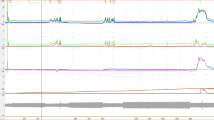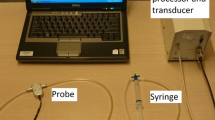Abstract
The aim of this study was to compare pressure readings obtained with catheter-mounted microtip and external water pressure transducers using a mechanical model for vesical pressure during Valsalva straining and coughing. The two catheter-mounted pressure transducers were simultaneously placed in a vinyl IV bag designed to mimic the parameters of the human bladder to allow comparison of simultaneous readings from both transducers. Simulated cough and Valsalva maneuvers of various strengths at different volumes (100 ml, 200 ml, 300 ml) were performed and the pressure readings generated by the two systems compared. The Pearson correlation coefficient between the systems was 0.998 for coughs and 0.998 for Valsalva efforts. Data were also analyzed by volume and strength of simulated cough and Valsalva effort, and correlations were found to be high (≥0.940) for all subgroup analyses. Mean absolute differences between events recorded by the two systems were small, as indicated by the y-intercept of 3.76 cmH2O pressure. Neither transducer recorded consistently higher pressures than the other. We concluded that there is a high correlation between pressure measurements obtained from microtip and external water pressure transducers during simulated cough and Valsalva efforts in this model. As similar correlation should exist in vivo, urodynamic data generated by the two transducer types should be comparable.



Similar content being viewed by others
Abbreviations
- ISD:
-
Intrinsic sphincter deficiency
- LPP:
-
Leak-point pressure
References
Abrams P, Cardozo L, Fall M et al. (2002) The standardization of terminology of lower urinary tract function: report from the Standardisation Sub-committee of the International Continence Society. Am J Obstet Gynecol 187:116–126
Bump RC, Elser DM, Theofrastous JP, McClish DK (1995) Valsalva leak point pressures in women with genuine stress incontinence: reproducibility, effect of catheter caliber, and correlations with other measures of urethral resistance. Continence Program for Women Research Group. Am J Obstet Gynecol 173:551–557
Swift SE, Utrie JW (1996) The need for standardization of the valsalva leak-point pressure. Int Urogynecol J 7:227–230
Swift SE, Yoon EA (1999) Test–retest reliability of the cough stress test in the evaluation of urinary incontinence. Obstet Gynecol 94:99–102
Miklos JR, Sze EH, Karram MM (1995) A critical appraisal of the methods of measuring leak-point pressures in women with stress incontinence. Obstet Gynecol 86:349–352
Sand PK, Bowen LW, Panganiban R, Ostergard DR (1987) The low pressure urethra as a factor in failed retropubic urethropexy. Obstet Gynecol 69:399–402
Hilton P, Stanton SL (1983) Urethral pressure measurement by microtransducer: the results in symptom-free women and in those with genuine stress incontinence. Br J Obstet Gynaecol 90:919–933
McGuire EJ (1981) Urodynamic findings in patients after failure of stress incontinence operations. Prog Clin Biol Res 78:351–360
Wang AC, Chen MC (2002) A comparison of urethral pressure profilometry using microtip and double-lumen perfusion catheters in women with genuine stress incontinence. Br J Obstet Gynaecol 109:322–326
Rowan D, James ED, Kramer AE, Sterling AM, Suhel PF (1987) Urodynamic equipment: technical aspects. Produced by the International Continence Society Working Party on Urodynamic Equipment. J Med Eng Technol 11:57–64
Author information
Authors and Affiliations
Corresponding author
Additional information
Editorial Comment: There are many technical variations in urodynamic testing, including the type of catheter used. These authors found that results obtained with perfusion and microtip catheters were highly correlated. As would be expected, they were able to demonstrate a time lag in the pressure recordings from perfusion catheters. As a result of this lag the amplitude of a cough leak point might be underestimated by a perfusion catheter. However, their results suggest that the magnitude of this underestimation would not be clinically relevant. In summary, this paper suggests that the pressures measured by microtip catheters and perfusion catheters are similar. It remains to be seen whether these results can be replicated in vivo.
Rights and permissions
About this article
Cite this article
Hundley, A.F., Visco, A.G. Comparison of measurements obtained with microtip and external water pressure transducers. Int Urogynecol J 15, 276–280 (2004). https://doi.org/10.1007/s00192-004-1157-5
Received:
Accepted:
Published:
Issue Date:
DOI: https://doi.org/10.1007/s00192-004-1157-5




